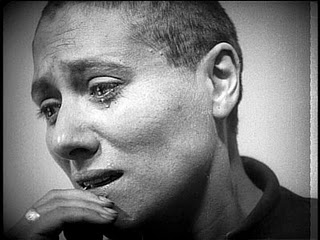The setting for The Passion of Joan of Arc, staged at Christ Church Cathedral on Burrard street, lent a aura of rarefied theatricality to this event. The church's vaulted ceilings, echoing with the buzz of the audience, the polished wood floors and intricate lighting fixtures, the dramatic architecture of the nave itself, with its adjacent alcoves like wings to a stage – these conspired to create a sense of immanent revelation. Where a black box theatre lets distractions disappear form view, the finely-crafted environment of a church makes the setting itself a player in the drama.
The Passion of Joan of Arc was a multimedia affair: composer Stephan Smulovitz has created a score to accompany Carl Dreyer's 1928 silent film of the same name. The music was performed live by singer Viviane Houle and The Eye of Newt Ensemble, with text by poet Colin Browne.
The event was about the collision of ideas and eras, the merging of tradition and innovation: a projection screen hung in a hundred-year-old church allowed the audience to view Dreyer's mysterious film (once thought lost to fire but rediscovered in it's entirety in a janitor's closet in an Oslo mental institution in 1981). Contemporary music, interpreted by a modern jazz ensemble, made use of the church's huge pipe organ. Real-time poetry was layered over a projected drama whose filming predates most the century's major technological innovations.
From a conceptual point of view, The Passion of Joan of Arc was excellent: an aesthetically stunning and mind-bending experience. One's sense of time and place was carefully and beautifully shattered, so that the film's drama – the trial and martyrdom of Joan of Arc – was lifted off the screen and brought into the physical space of the present. The somber music of the pipe organ, played from the choir loft opposite the video screen created an underlying sense of anxiety, and the sounds seemed to resonate through one's bones. Stringed instruments alternated between urgent sharp notes – as if echoing the imprisoned woman's adrenaline rush of fear, her frantic pulse – and longer passages that expressed a sense of loss. The bright tones of the brass instruments cut through all of these, suggesting resolve, Joan of Arc's strong religious faith.
The moments when Houle sang lyrics written by Brown were particularly effective. The songs seem to capture Joan of Arc's inner life and feelings, immersing the audience in their melancholy sounds. The immediacy of the music was layered over and against the frantic action on the screen, where the woman's body was being bound, imprisoned, and tortured.
The words – some of which are excerpts from the actual transcripts of the trial – created a sense of introspection that lent depth to the film. In one of the final scenes, Joan of Arc stands on the executioners platform staring at a human skull dug from the graveyard where she will be buried. Maggots writhe in the eye socket. At this moment Houle sang: “I'm sailing over green earth / ... / His voice in the hedges / my Lord in the hedges.” The disjunction between the images on screen and the lyrics underscored the power that religious faith had for the woman on trial, and in a subtle way, the lyrics ground her faith in a love for all things earthly and natural.
The fusion of the old and the new is effective but not perfect in the PuSH Festival's The Passion of Joan of Arc. There are peak moments where the music and lyrics conjoin with the on-screen narrative and the whole becomes more that the sum of its parts. At other moments, where the musical accompaniment was less dynamic it felt more like a traditional soundtrack, secondary to the film and submerged in the whole rather than giving it greater structure and weight. This effect was intensified by the fact that some of the scoring seemed a touch traditional. The stringed instruments and the organ (though used effectively in many places during the performance) are touchstone instruments for early Hollywood film, used to create moods of fear, angst, and romance, and there were moments in The Passion of Joan of Arc when the tone they evoked seemed all too familiar. Nonetheless there were a number of moments of real and startling synergy between film and performance, and this made for a uniquely moving theatrical experience.




